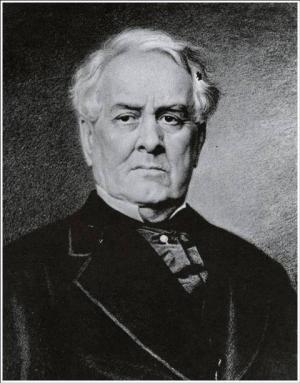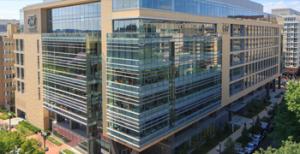History
In 1884, William Corcoran transformed science and engineering education in the District of Columbia when he founded the Corcoran Scientific School, now known as the George Washington University's School of Engineering and Applied Science. Corcoran was neither an engineer nor a scientist. He was a retired banker who saw the world's growing confidence in scientific discovery in the late 1800's and marveled at the impact of technological advances in his own lifetime. Not wanting the District to be without such a center of scientific discovery--at a time when the first steel frame skyscraper was constructed, when gas-powered automobiles were first being designed and built, when electric lighting was becoming commercially available--William Corcoran paved the way for future discoveries and transformation by providing the founding gift for the school.
By the start of the first world war in 1914 the Washington School of Engineering had moved from its building at 15th and H Streets to a new campus at Foggy Bottom. That move symbolized a major change, as it moved the school beyond William Corcoran’s 19th century vision of a scientific school and created the seed for a modern engineering college. It was during this time that the Washington School of Engineering took the name George Washington University School of Engineering
Both the first and second world wars strengthened the ties between the military and engineering schools, as the school devoted itself to providing technical education to new officers. During the second world war the school’s research program was greatly aided by the Office of Scientific Research and Development, the organization that was created to provide the military with research support. Located only a few blocks from the headquarters of the organization, the Engineering School was in a good position to learn of projects and to promote its faculty. In 1943, the school won the contract to manage rocket and ordnance research at the Cumberland Arsenal in Maryland. In this work, university faculty developed the recoilless anti-tank rifle (popularly known as the Bazooka), a variety of short range mortars, and a number of elements of small rockets. In this work, it cooperated with the California Institute of Technology that later became the Jet Propulsion Laboratory. By the end of the war, the Engineering school was the 8th largest university contractor with the Office of Scientific Research and Development, following only MIT, Cal Tech, Harvard, Columbia, the University or California Berkeley, Johns Hopkins and the University of Chicago.
After the end of the second world war, the Engineering School acquired a building of its own. In 1947, Charles Hook Tompkins, an alumnus of the school, offered $22,500 to build a new facility. Tompkins had built a number of buildings for the university, including the hospital and Lisner Auditorium. Construction began in 1954 and finished two years later.
In the years that followed the completion of Tompkins Hall, the school moved into its modern form. Aided by the renewed interest in science and technology that followed the launce of the Russian satellite Sputnik in 1957, it shed outmoded programs and strengthened new ones. The school’s original program in mining engineering was long gone. Naval architecture had vanished a few years after the second world war. As the school moved into its new role it added courses in computer science and aeronautical engineering. In 1962, it acquired its current name, the School of Engineering and Applied Science (SEAS).
Fifty years have passed since the School took its current name. Much else has changed along the way at SEAS. New technologies and curricula and even new departments have been added to prepare subsequent generations of engineers and computer scientists working in these emerging fields.
In late 2011, SEAS began the latest chapter of its story, with the Science and Engineering Hall groundbreaking. When it was completed in late 2014, this $300 million, 500,000 square foot, state-of-the-art building became the home of SEAS research in biomedical engineering, cybersecurity, high-performance computing, nanotechnologies, robotics, and many other fields. From this new base, SEAS continues to leverage its strong research programs to recruit the very best faculty, attract outstanding graduate students, and offer exciting and challenging research opportunities to its undergraduate students.





